We’ve finished up most of our training, and are starting to get involved with some of the volunteer projects that the Shoreline Education for Awareness (SEA) and US Fish & Wildlife sponsor. This is the most diverse volunteer position we’ve been involved in; our training covered subjects such as whales, tide pools, shorebirds of the area, wetlands restoration, and our recent challenge – searching for invertebrates in the tidal flats.
 We’re working with the “Shoreline Sisters”, two young ladies from USF&W who teach elementary school students about shorebirds. After four classes at their school, the students are bussed to the Bandon Marsh National Wildlife Refuge
We’re working with the “Shoreline Sisters”, two young ladies from USF&W who teach elementary school students about shorebirds. After four classes at their school, the students are bussed to the Bandon Marsh National Wildlife Refuge 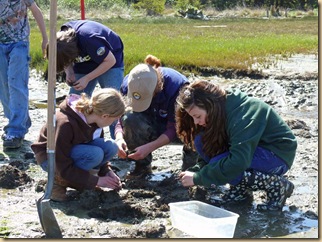
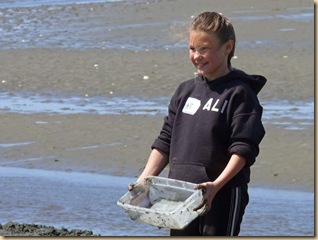 where volunteers teach them to use spotting scopes to identify shorebirds, see them up close with a presentation from Free Flight, a bird rehabilitation center, and finally, a chance to get up close and personal with the creatures that shorebirds eat. One-third of the class at a time is giving instructions on how to use a shovel and what to look for, and with plastic tub and shovel in hand, off they go into the mud to look for treasures. It’s an interesting mix of personalities at this, the 5th-grade level; there are the “dive in and get muddy” kids, and the manicured young divas who aren’t too crazy about touching mud-encrusted worms and bugs. But after a while, even the divas dive in, the lure of unknown treasures finally winning out. Mostly they find Polychaetes, a bristly, squirmy worm, s
where volunteers teach them to use spotting scopes to identify shorebirds, see them up close with a presentation from Free Flight, a bird rehabilitation center, and finally, a chance to get up close and personal with the creatures that shorebirds eat. One-third of the class at a time is giving instructions on how to use a shovel and what to look for, and with plastic tub and shovel in hand, off they go into the mud to look for treasures. It’s an interesting mix of personalities at this, the 5th-grade level; there are the “dive in and get muddy” kids, and the manicured young divas who aren’t too crazy about touching mud-encrusted worms and bugs. But after a while, even the divas dive in, the lure of unknown treasures finally winning out. Mostly they find Polychaetes, a bristly, squirmy worm, s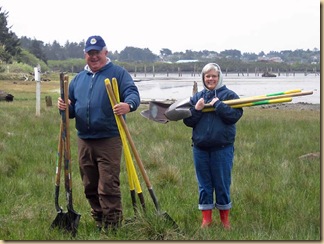 mall clams, and isopods, small, many-
mall clams, and isopods, small, many-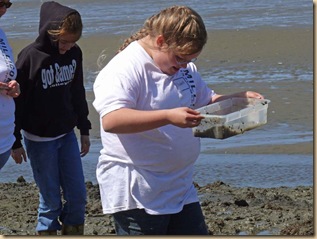 legged little crustaceans. After a few discoveries and shouts of success, the digging becomes a contest, and soon all of the kids are poring through the mud trying to become the leader in critter-gathering. It’s great fun, although hard work, slogging through the mud and occasionally trying to pull a stuck student out of the cement-like goo (it’s always the BIG ones). The two young ladies of “Shoreline Sisters” are amazing – patient, upbeat, hard working – it’s a great program and hopefully the kids will grow up with an appreciation for the wildlife around them.
On Saturday, we picked up fellow volunteers Don and Betty and headed into Charleston to the Oregon Institute of Marine Biology
legged little crustaceans. After a few discoveries and shouts of success, the digging becomes a contest, and soon all of the kids are poring through the mud trying to become the leader in critter-gathering. It’s great fun, although hard work, slogging through the mud and occasionally trying to pull a stuck student out of the cement-like goo (it’s always the BIG ones). The two young ladies of “Shoreline Sisters” are amazing – patient, upbeat, hard working – it’s a great program and hopefully the kids will grow up with an appreciation for the wildlife around them.
On Saturday, we picked up fellow volunteers Don and Betty and headed into Charleston to the Oregon Institute of Marine Biology 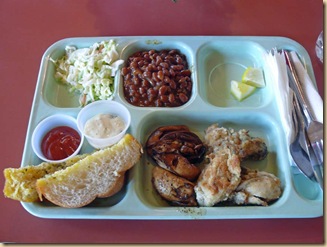 and their “Aw Shucks” oyster
and their “Aw Shucks” oyster 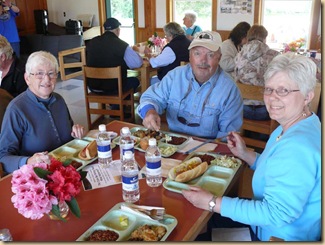 feed. For a reasonable fee, we were served a cafeteria-style dinner of oysters (choice of breaded, sautéed, or barbequed) with side dishes and drinks. As you can see by the picture, Don and I enjoyed the oysters, while Betty and Brenda opted for hot dogs instead. Which of course proves once again that only real men eat oysters! We had to wonder though, since this was a “marine biology” school, if we were eating the leftover cadavers of oyster research…….but they were tasty!
This week we’ll spend some more time with the Shoreline Sisters and also spend time on an overlook showing folks the seals and sea lions. In between there’s lots in the area to explore, so c’mon back and visit!
feed. For a reasonable fee, we were served a cafeteria-style dinner of oysters (choice of breaded, sautéed, or barbequed) with side dishes and drinks. As you can see by the picture, Don and I enjoyed the oysters, while Betty and Brenda opted for hot dogs instead. Which of course proves once again that only real men eat oysters! We had to wonder though, since this was a “marine biology” school, if we were eating the leftover cadavers of oyster research…….but they were tasty!
This week we’ll spend some more time with the Shoreline Sisters and also spend time on an overlook showing folks the seals and sea lions. In between there’s lots in the area to explore, so c’mon back and visit!
Leaving the Black Hills, we headed west, then south to connect with I-80. As we headed south on I-25, the snow-covered Bighorn Mountains graced the western 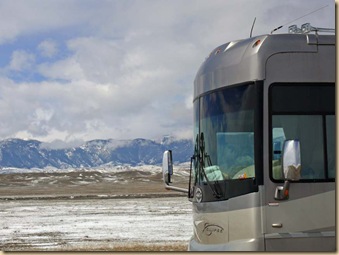 horizon. Although it was cold, the sunny skies and beautiful scenery made for a nice drive in spite of the usual headwind.
horizon. Although it was cold, the sunny skies and beautiful scenery made for a nice drive in spite of the usual headwind. 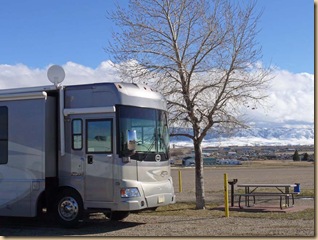 We spent the night in Casper, where we were one of only three RVs in the KOA, then continued on to join I-80. We spent the night (by ourselves) in a nice park in Fort Bridger, where the owner advised us to watch where we walked to avoid the moose droppings.
We spent the night in Casper, where we were one of only three RVs in the KOA, then continued on to join I-80. We spent the night (by ourselves) in a nice park in Fort Bridger, where the owner advised us to watch where we walked to avoid the moose droppings.  If you’ve followed our travels, you know that the sight of anything moose-like energized Brenda, and she was at the windows with the binoculars throughout our stay. The next morning, after a mooseless night, I used Windex to clean her nose-prints from the windshield, and we headed off again.
The rest of our westbound trip was fairly uneventful, with stops at Wells and Sparks, Nevada, and Corning, California.
If you’ve followed our travels, you know that the sight of anything moose-like energized Brenda, and she was at the windows with the binoculars throughout our stay. The next morning, after a mooseless night, I used Windex to clean her nose-prints from the windshield, and we headed off again.
The rest of our westbound trip was fairly uneventful, with stops at Wells and Sparks, Nevada, and Corning, California. 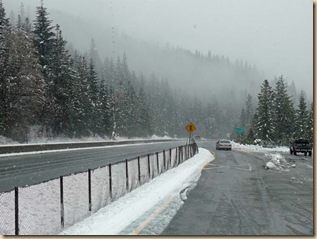 While at Corning, the weather threatened to delay us again, as early in the morning I-5 was closed near the Oregon border due to heavy snow. The road was eventually opened, although heavy snow and a wet road made travel a bit sporty. It was beautiful, though, with pancake-sized flakes softly floating down onto the trees…..and windshield.
We finally arrived at our home for the summer at Bullards Beach State Park.
While at Corning, the weather threatened to delay us again, as early in the morning I-5 was closed near the Oregon border due to heavy snow. The road was eventually opened, although heavy snow and a wet road made travel a bit sporty. It was beautiful, though, with pancake-sized flakes softly floating down onto the trees…..and windshield.
We finally arrived at our home for the summer at Bullards Beach State Park. 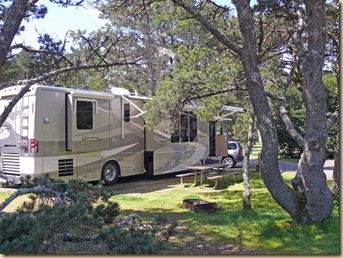 One of the perks of volunteering is a free site with hookups, and we were given a prime place to park with lots of room. It’s good to be somewhere for a while, although we didn’t have much time to sit around since our delay took resulted in our arrival just prior to training for the wildlife interpreters. Our position here is a bit unusual; we actually work for the Shoreline Education for Awareness (SEA) organization, which is the “friends” group for the local US Fish & Wildlife refuge. We’ll be primarily spending our time on USF&W duties, but since we reside in the state park, we’ll also have projects to earn our site, primarily acting as Snowy Plover interpreters. In any case, our commitment is for 24 hours each per week, which leaves us a lot of time to explore the area…….and restaurants.
One of the perks of volunteering is a free site with hookups, and we were given a prime place to park with lots of room. It’s good to be somewhere for a while, although we didn’t have much time to sit around since our delay took resulted in our arrival just prior to training for the wildlife interpreters. Our position here is a bit unusual; we actually work for the Shoreline Education for Awareness (SEA) organization, which is the “friends” group for the local US Fish & Wildlife refuge. We’ll be primarily spending our time on USF&W duties, but since we reside in the state park, we’ll also have projects to earn our site, primarily acting as Snowy Plover interpreters. In any case, our commitment is for 24 hours each per week, which leaves us a lot of time to explore the area…….and restaurants.
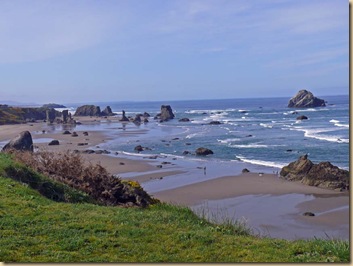
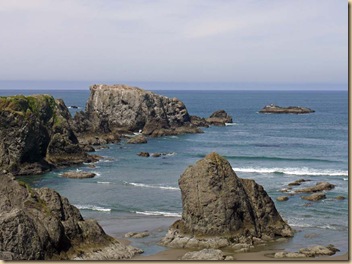 We’ve been busy with SEA activities on an overlook called Coquille Point, a magical place that overlooks the rugged rocks and coastline. It’s where we’ll spend time helping visitors see and understand the shorebirds and mammals that make the rocks
We’ve been busy with SEA activities on an overlook called Coquille Point, a magical place that overlooks the rugged rocks and coastline. It’s where we’ll spend time helping visitors see and understand the shorebirds and mammals that make the rocks  home. The season kicked off with a “Puffin Party” to welcome back an amazing little bird, the Tufted Puffin. We helped set up spotting scopes and assist visitors hunting for a puffin, but we were “puffinless” as we watched gulls, murres, and even oystercatchers on the rocks. We did have a visit from some very
home. The season kicked off with a “Puffin Party” to welcome back an amazing little bird, the Tufted Puffin. We helped set up spotting scopes and assist visitors hunting for a puffin, but we were “puffinless” as we watched gulls, murres, and even oystercatchers on the rocks. We did have a visit from some very 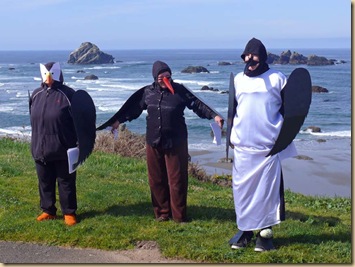 large and happy birds – a giant puffin, oystercatcher, and murre (note the egg on the foot of the murre; like penguins, the males carry it around), and celebrated their arrival with brownies, cupcakes, and coffee. Suddenly a shout went up – a puffin! We quickly hit the scopes, and sure enough, there on the rocks was a lone Tufted Puffin, magnificent in breeding plumage and putting on a show for the crowd. He stayed long enough for everyone to get a look, then flew off to amaze others on the coast. They’re very rare here, and we feel fortunate to have seen one of these fascinating little birds.
After a while, we took down the scopes, packed up, and adjourned to a local restaurant for lunch and a much needed opportunity to sit and relax. We had a great time meeting our fellow out of state volunteers and the local volunteers who give so much time and effort to this program. For the next week we’ll be involved in seminars, field trips, and on-the-job training to prepare us for the summer. We’re having a ball – great people, interesting training, beautiful location; it doesn’t get much better than this! C’mon back and see how we’re doing.
large and happy birds – a giant puffin, oystercatcher, and murre (note the egg on the foot of the murre; like penguins, the males carry it around), and celebrated their arrival with brownies, cupcakes, and coffee. Suddenly a shout went up – a puffin! We quickly hit the scopes, and sure enough, there on the rocks was a lone Tufted Puffin, magnificent in breeding plumage and putting on a show for the crowd. He stayed long enough for everyone to get a look, then flew off to amaze others on the coast. They’re very rare here, and we feel fortunate to have seen one of these fascinating little birds.
After a while, we took down the scopes, packed up, and adjourned to a local restaurant for lunch and a much needed opportunity to sit and relax. We had a great time meeting our fellow out of state volunteers and the local volunteers who give so much time and effort to this program. For the next week we’ll be involved in seminars, field trips, and on-the-job training to prepare us for the summer. We’re having a ball – great people, interesting training, beautiful location; it doesn’t get much better than this! C’mon back and see how we’re doing.
It took us a bit longer than we planned, but we’re finally in the Rapid City, South Dakota area where we have to renew our driver’s licenses before continuing on westward. We had an unexpected maintenance issue and diverted to the Winnebago factory in Forest City, Iowa for a few days, but everything’s back to normal (except the weather). Because of the Easter Holidays, the licensing office was closed from Friday until today, so we had time to roam the area and see some of the popular tourist spots without any crowds.
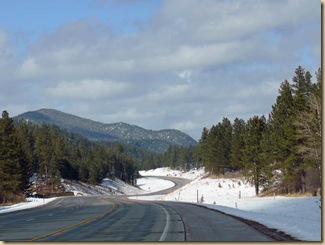 Spring has been a little late to arrive in the Black Hills – there’s still snow covering the trees and meadows, and the most of the lakes are
Spring has been a little late to arrive in the Black Hills – there’s still snow covering the trees and meadows, and the most of the lakes are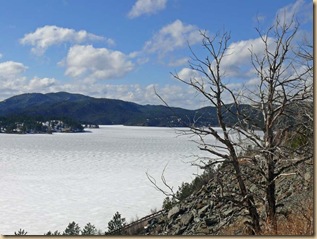 still completely frozen. Most of the tourist attractions are still closed, but you get a sense from the huge amount of motels, campgrounds, and amusements that this must be a bustling place in the summer.
We’re in a campground (in fact, we’re the ONLY ones in the campground), just down the road from Sturgis, famous for it’s annual motorcycle rally. Sturgis is a small town of just over 6000, but during the rally, it becomes not only South Dakota’s biggest city, but the crowd nearly exceeds the entire state’s population. In 2000, the rally attendance was officially listed as 754,844, and although last year’s attendance was down, it’s the largest, and nosiest, motorcycle event in the world. You can read a great article describing the event here.
still completely frozen. Most of the tourist attractions are still closed, but you get a sense from the huge amount of motels, campgrounds, and amusements that this must be a bustling place in the summer.
We’re in a campground (in fact, we’re the ONLY ones in the campground), just down the road from Sturgis, famous for it’s annual motorcycle rally. Sturgis is a small town of just over 6000, but during the rally, it becomes not only South Dakota’s biggest city, but the crowd nearly exceeds the entire state’s population. In 2000, the rally attendance was officially listed as 754,844, and although last year’s attendance was down, it’s the largest, and nosiest, motorcycle event in the world. You can read a great article describing the event here.
 No trip to the Black Hills would be complete without a visit to Mount Rushmore, and so off we went on a dreary morning with snow showers and drizzle. The drive took us through Rapid City, a busy town with lots of restaurants and shopping, and then we began a slow climb into the pine-forested Black Hills.
No trip to the Black Hills would be complete without a visit to Mount Rushmore, and so off we went on a dreary morning with snow showers and drizzle. The drive took us through Rapid City, a busy town with lots of restaurants and shopping, and then we began a slow climb into the pine-forested Black Hills. 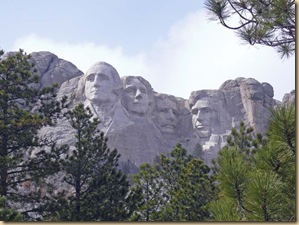 It’s a pretty area; the hills are really mountains, not especially high but rugged and beautiful nonetheless. The memorial has been heavily renovated; now when you arrive you pay a $10 parking fee to a concessionaire, then enter multi-level parking garages, which allows the parking to be a short walk to the memorial area. A wide, granite walkway
It’s a pretty area; the hills are really mountains, not especially high but rugged and beautiful nonetheless. The memorial has been heavily renovated; now when you arrive you pay a $10 parking fee to a concessionaire, then enter multi-level parking garages, which allows the parking to be a short walk to the memorial area. A wide, granite walkway 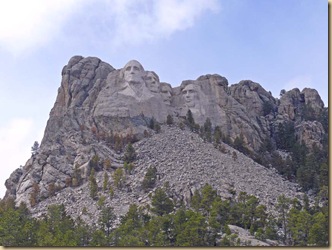 decorated with state flags leads to an overlook and below that, an area of theaters, exhibits, and a bookstore. Standing at the overlook, you can’t help but be amazed at the clarity and lifelike appearance sculpted out of the granite – no wonder it took 14 years and hundreds of workers to complete.
decorated with state flags leads to an overlook and below that, an area of theaters, exhibits, and a bookstore. Standing at the overlook, you can’t help but be amazed at the clarity and lifelike appearance sculpted out of the granite – no wonder it took 14 years and hundreds of workers to complete.  Amazingly, although workers hung over the mountain sides in crude harnesses, climbed around on flimsy scaffolding, and used dynamite to remove 90% of the rock, no one was killed during the construction. It was a great visit – inspiring, educational, and memorable; and the weather even cooperated by clearing and providing a sunny afternoon.
Amazingly, although workers hung over the mountain sides in crude harnesses, climbed around on flimsy scaffolding, and used dynamite to remove 90% of the rock, no one was killed during the construction. It was a great visit – inspiring, educational, and memorable; and the weather even cooperated by clearing and providing a sunny afternoon.
 On the path back to the parking garage, we came across a small group of Mountain goats. They weren’t fazed by the people walking by, and were interesting to watch. Not native to South Dakota, they were introduced in 1929 and have been residents ever since, although the numbers have declined in recent years due to an increasing mountain lion population and a reduction in habitat.
On the path back to the parking garage, we came across a small group of Mountain goats. They weren’t fazed by the people walking by, and were interesting to watch. Not native to South Dakota, they were introduced in 1929 and have been residents ever since, although the numbers have declined in recent years due to an increasing mountain lion population and a reduction in habitat.
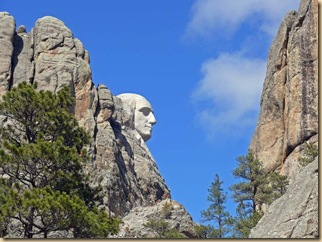
 From Mount Rushmore, we decided to continue on the road to the Crazy Horse Mountain Memorial, but in just a short while came across this interesting view of the profile of George Washington. Continuing on, we came to a place on the highway where we could see the massive sculpture, which will be the largest in the world if ever completed. Started in 1948 by a man who worked on Mount Rushmore, the project is non-profit and does not receive any federal or state funding. We were running out of daylight, so opted to pass $20 entrance fee and continue on the highway back to Sturgis.
We also took the time to explore the small towns of Lead (pronounced “leed”) and Deadwood. Lead was interesting in a strange way – it looked a lot like a Western
From Mount Rushmore, we decided to continue on the road to the Crazy Horse Mountain Memorial, but in just a short while came across this interesting view of the profile of George Washington. Continuing on, we came to a place on the highway where we could see the massive sculpture, which will be the largest in the world if ever completed. Started in 1948 by a man who worked on Mount Rushmore, the project is non-profit and does not receive any federal or state funding. We were running out of daylight, so opted to pass $20 entrance fee and continue on the highway back to Sturgis.
We also took the time to explore the small towns of Lead (pronounced “leed”) and Deadwood. Lead was interesting in a strange way – it looked a lot like a Western 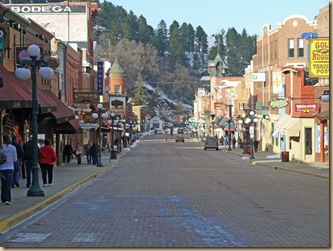 Pennsylvania mining town; small houses crowding each other on steep hillsides, narrow streets, old buildings in disrepair. It has an interesting history, but isn’t exactly a scenic place to spend time. Deadwood, on the other hand, has been largely restored and is the state’s only gaming community. The town sits in a narrow gully and it’s main street is an 1800s replica of saloons and stores, most of which house casinos. These are not the casinos of Las Vegas, most are housed in one or two storefronts and have a few dozen slot machines and a couple of poker and blackjack tables. Cramped and smoky, we didn’t spend much time here, and as you can see by the picture, it wasn’t exactly a busy night on the strip.
Hopefully the weather will clear and allow us to continue our journey, but spring in this part of the country is always unpredictable. Stop back and see how we’re doing!
Pennsylvania mining town; small houses crowding each other on steep hillsides, narrow streets, old buildings in disrepair. It has an interesting history, but isn’t exactly a scenic place to spend time. Deadwood, on the other hand, has been largely restored and is the state’s only gaming community. The town sits in a narrow gully and it’s main street is an 1800s replica of saloons and stores, most of which house casinos. These are not the casinos of Las Vegas, most are housed in one or two storefronts and have a few dozen slot machines and a couple of poker and blackjack tables. Cramped and smoky, we didn’t spend much time here, and as you can see by the picture, it wasn’t exactly a busy night on the strip.
Hopefully the weather will clear and allow us to continue our journey, but spring in this part of the country is always unpredictable. Stop back and see how we’re doing!
 We’re working with the “Shoreline Sisters”, two young ladies from USF&W who teach elementary school students about shorebirds. After four classes at their school, the students are bussed to the Bandon Marsh National Wildlife Refuge
We’re working with the “Shoreline Sisters”, two young ladies from USF&W who teach elementary school students about shorebirds. After four classes at their school, the students are bussed to the Bandon Marsh National Wildlife Refuge 
 where volunteers teach them to use spotting scopes to identify shorebirds, see them up close with a presentation from Free Flight, a bird rehabilitation center, and finally, a chance to get up close and personal with the creatures that shorebirds eat. One-third of the class at a time is giving instructions on how to use a shovel and what to look for, and with plastic tub and shovel in hand, off they go into the mud to look for treasures. It’s an interesting mix of personalities at this, the 5th-grade level; there are the “dive in and get muddy” kids, and the manicured young divas who aren’t too crazy about touching mud-encrusted worms and bugs. But after a while, even the divas dive in, the lure of unknown treasures finally winning out. Mostly they find Polychaetes, a bristly, squirmy worm, s
where volunteers teach them to use spotting scopes to identify shorebirds, see them up close with a presentation from Free Flight, a bird rehabilitation center, and finally, a chance to get up close and personal with the creatures that shorebirds eat. One-third of the class at a time is giving instructions on how to use a shovel and what to look for, and with plastic tub and shovel in hand, off they go into the mud to look for treasures. It’s an interesting mix of personalities at this, the 5th-grade level; there are the “dive in and get muddy” kids, and the manicured young divas who aren’t too crazy about touching mud-encrusted worms and bugs. But after a while, even the divas dive in, the lure of unknown treasures finally winning out. Mostly they find Polychaetes, a bristly, squirmy worm, s mall clams, and isopods, small, many-
mall clams, and isopods, small, many- legged little crustaceans. After a few discoveries and shouts of success, the digging becomes a contest, and soon all of the kids are poring through the mud trying to become the leader in critter-gathering. It’s great fun, although hard work, slogging through the mud and occasionally trying to pull a stuck student out of the cement-like goo (it’s always the BIG ones). The two young ladies of “Shoreline Sisters” are amazing – patient, upbeat, hard working – it’s a great program and hopefully the kids will grow up with an appreciation for the wildlife around them.
legged little crustaceans. After a few discoveries and shouts of success, the digging becomes a contest, and soon all of the kids are poring through the mud trying to become the leader in critter-gathering. It’s great fun, although hard work, slogging through the mud and occasionally trying to pull a stuck student out of the cement-like goo (it’s always the BIG ones). The two young ladies of “Shoreline Sisters” are amazing – patient, upbeat, hard working – it’s a great program and hopefully the kids will grow up with an appreciation for the wildlife around them. and their “Aw Shucks” oyster
and their “Aw Shucks” oyster  feed. For a reasonable fee, we were served a cafeteria-style dinner of oysters (choice of breaded, sautéed, or barbequed) with side dishes and drinks. As you can see by the picture, Don and I enjoyed the oysters, while Betty and Brenda opted for hot dogs instead. Which of course proves once again that only real men eat oysters! We had to wonder though, since this was a “marine biology” school, if we were eating the leftover cadavers of oyster research…….but they were tasty!
feed. For a reasonable fee, we were served a cafeteria-style dinner of oysters (choice of breaded, sautéed, or barbequed) with side dishes and drinks. As you can see by the picture, Don and I enjoyed the oysters, while Betty and Brenda opted for hot dogs instead. Which of course proves once again that only real men eat oysters! We had to wonder though, since this was a “marine biology” school, if we were eating the leftover cadavers of oyster research…….but they were tasty!

















